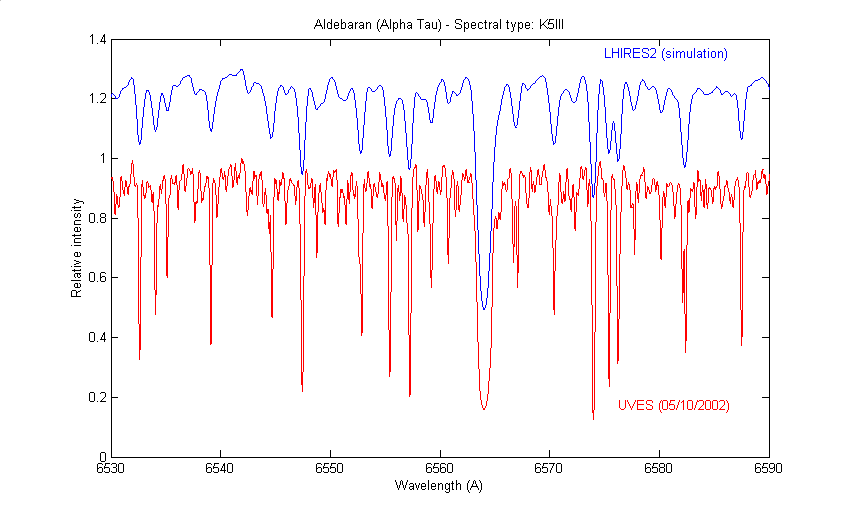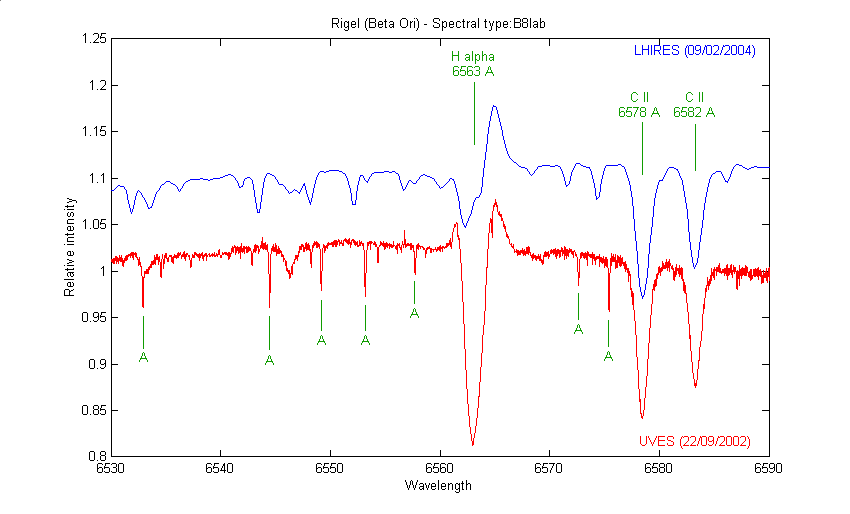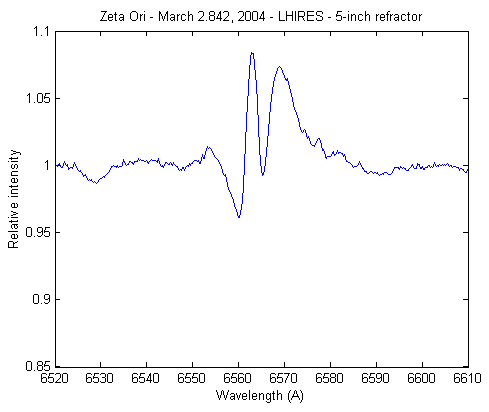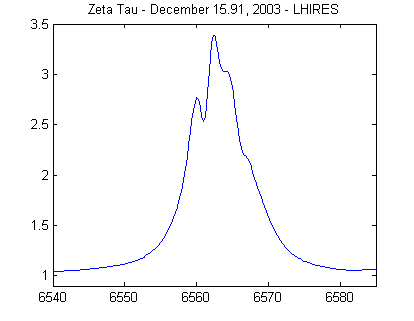
http://astrosurf.com/aras
Discussion list ARAS / Liste de discussion ARAS
ARAS key project
LHIRES2 spectrograph

http://astrosurf.com/aras
Discussion
list ARAS / Liste de discussion ARAS
ARAS key project
LHIRES2 spectrograph
Ha
high
resolution spectrograph for Schmidt-Cassegrain telescopes
and F/7 to F/10 refractors
Un
spectrographe Ha
haute-résolution pour télescopes Schmidt-Cassegrain et lunettes ouvertes à F/7-10


Dans
cette page : les performances de LHIRES2, des exemples de programmes scientifiques
et les plans détaillés.
1. Summary of specification
The LHIRES2 spectrograph can be used on small amateur
telescopes for joint scientific programs between professionals/amateurs
and for pedagogical purpose.
Le spectrographe LHIRES2 peut être utilisé sur des petits télescopes amateur dans la perspective du collaboration scientifique entre amateurs et professionnels, ainsi que pour une approche pédagogique et pratique de l'astrophysique.
Performance evaluation for slitless mode, for a seeing of 3 arc-seconds
and an exposure of 1 hour (at 6563 A and a A0V type star)
Evaluation
de la performance pour une utilisation sans fente, un seeing de 3 secondes d'arc et une heure
de pose (à la longueur d'onde de 6563 A et pour une étoile de type A0V)
|
TELESCOPE |
RESOLUTION |
SPECTRAL RANGE |
SAMPLING |
LIMIT MAG. |
LIMIT MAG. |
|
Lun. 128 mm |
18000 |
6520 - 6600 |
0.12 |
5.8 |
4.5 |
Performance evaluation for slit mode, seeing of 3 arc-seconds
and an exposure of 1 hour (at 6563 A and a A0V type star)
Evaluation
de la performance pour une utilisation avec fente, un seeing de 3 secondes d'arc et une heure
de pose (à la longueur d'onde de 6563 A et pour une étoile de type A0V)
|
TELESCOPE |
RESOLUTION |
SPECTRAL RANGE |
SAMPLING |
LIMIT MAG. |
MAG. LIMIT |
|
600 mm F/D=10 |
15000 |
6520 - 6600 |
0.23 |
9.4 |
8.1 |
2. Performance simulation

Well, the superior resolution of UVES is very evident! Now, the resolution of the UVES spectrum is degraded to reach the LHIRES resolution (convolution by a gaussian function):
S'en surprise, le supériorité de UVES est très supérieure. Mais la comparaison ne porte pas sur ce point. La résolution spectrale de UVES a été dégradée pour être rendue compatible avec celle de LHIRES (le spectre du VLT a été convolué par une fonction gaussienne pour cela) :

The consistency of LHIRES and UVES spectra is excellent. This proves the good reliability of LHIRES.
The following figure shows a comparison of the UVES spectrum and a simulated LHIRES2 spectrum with the resolution of 18,000.
La consistance du spectre LHIRES avec le spectre de UVES est excellente, ce qui montre que pour la résolution spectrale visée les résultats obtenu avec un spectrographe type LHIRES sur un petit télescope amateur sont fiables et scientifiquement exploitables.
Le figure suivante montre pour la même étoile une simulation à une résolution spectrale de 18 000, qui est l'objectif visé pour LHIRES2 :

3. Some scientific programs for LHIRES2
3.1
Ha
emission survey of high-luminosity supergiants
In the most luminous supergiant stars the continual or sporadic ejection of matter is a common phenomenon. Numerous stars of this type are accessible to the LHIRES2 spectrograph and a moderate aperture telescope (8-inch typically). The variability of the H alpha profile is highly variable and spectacular on different time scales reaching from days to months. The purpose of this survey is alert concerning exceptional events, the measure of velocity fields in the outer atmospheric region of this stars, search of pulsation or rotational modulation (tomography - dynamic spectra) and hydrodynamic studies.
The figure below concern the star Rigel (Beta Ori) and show an evidence of the variation of Ha profile if we compare a UVES spectrum and a recent LHIRES spectrum. Note that the spectral resolution of LHIRES (and LHIRES2 of course) is sufficient to resolve the lines of this area of the spectrum. Telluric lines are visible (water vapour) and have been marked ("A" letter). The wavelengths are reported to the heliocentric system. The LHIRES observation is made in Toulouse (France) with a 5-inch refractor and the cumulative exposure time is of 650 seconds.

Three days evolution of Rigel Ha profile (between February 9, 2004 and February 12, 2004) :

Another familiar star with spectrographic interest, the active supergiant Deneb (Alpha Cyg):


For
a catalog and observations of supergiants click here
3.2 Observation of
hot and massive stars
Look for example short term (5 days interval!) spectacular evolution a massive bright star, Zeta Ori (the "familiar" star near the famous Horse Nebula), observed with the LHIRES spectrograph and a 5-inch refractor:


For
a catalog and observations of massive stars click here
3.3 Survey of Be stars
The Be stars are defined to be rapidly rotating O, B, A-type stars of luminosity classes III-V which Balmer emission lines. Many B stars show these characteristics, but the Be stars correspond only to the class of non-supergiants (classes III to V). Approximately 10% of the non-supergiant B-type stars present the characteristics of the Be stars.
A characteristic of the Be stars comes from the variability of aspect of the hydrogen lines (and sometimes, helium and iron). Stars can on a cycle of a few years show lines in strong emission, usually completely absent (confused with the continuum) or in absorption as in a normal star. The frequency of the variations of the profile lines covers a very broad range since some Be stars can show certain line-profile changes in a few hours or minutes whereas others can remain stable during years. Sometimes several cycles of variations with very different periods can be superimposed. For a complete review about Be stars, click here.
An example, the time evolution of the star Zeta Tau:




For
a catalog and observations of Be stars click here
3.4 RS CVn stars
RS CVn are class of detached binary typically composed of a chromospherically active G or K stars. The system generally rotate fast with typical orbital period from a few days to 20 days. Tidal forces between the close components have locked their rotational periods to the orbital period. The RS CVn binaries display a high level of activity with strong chromospheric line emissions. One of the striking aspects of these systems is their propensity to flare. These stars shows rotational modulation of photospheric spots.and are also magnetically active (Doppler Imaging and Zeeman Doppler Imaging are classical technique used for map stellar surfaces of the RS CVn components).
Here the two days evolution of the RS CVn star UX Aries:


For
a catalog and observations of RS CVn stars click here
3.5 Spectroscopic double starsSurvey of Be stars
For pedagogical purpose (fine demonstration of Doppler effect and celestial mechanic) and because these objects are spectacular, the spectroscopic binary. Example, the fast swing of the component of 12 Boo:


For
observations of spectroscopic double stars click here
3. Design

Conception
André
Rondi et Christian Buil
For detailled
drawing, click here
Pour
des plans de détail, cliquer ici
Availability: summer 2004
Disponibilité
: été 2004